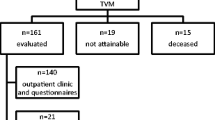Abstract
Introduction and hypothesis
EndoFast Reliant™ system is a novel technology for pelvic organ prolapse (POP) repair that attaches mesh directly with metal fasteners.
Methods
This was a prospective multicenter study in 20 women who underwent vaginal POP repair to evaluate safety and efficacy. The patients were followed for 12 months, using POP-Q measures, questionnaires on symptoms (PFDI), and sexual function (FSFI).
Results
No intraoperative complications occurred. Prolapse has been anatomically resolved (< stage 2) in 85% at 1-year follow-up (17/20 patients). Pelvic Floor Distress Inventory (PFDI) scores showed significant improvement for 1 year in symptoms related to prolapse (4.1–0.7, p < 0.001) and bladder (1.4–0.7, p = 0.06) but not to rectum. Female Sexual Function Index (FSFI) scores did not change significantly. One case of mesh exposure was found (5%) and treated conservatively. No migration of fasteners was observed on X-ray.
Conclusions
The EndoFast Reliant™ system was found safe and efficacious. Future studies are needed to evaluate its advantages over techniques using trocars.


Similar content being viewed by others
References
Hendrix SL, Clark A, Nygaard I, Aragaki A, Barnabei V, McTiernan A (2002) Pelvic organ prolapse in the Women's Health Initiative: gravity and gravidity. Am J Obstet Gynecol 186(6):1160–1166
Olsen AL, Smith VJ, Bergstrom JO, Colling JC, Clark AL (1997) Epidemiology of surgically managed pelvic organ prolapse and urinary incontinence. Obstet Gynecol 89(4):501–506
Nguyen JN, Burchette RJ (2008) Outcome after anterior vaginal prolapse repair: a randomized controlled trial. Obstet Gynecol 111(4):891–898
Nieminen K, Hiltunen R, Takala T, Heiskanen E, Merikari M, Niemi K, Heinonen PK (2010) Outcomes after anterior vaginal wall repair with mesh: a randomized, controlled trial with a 3 year follow-up. Am J Obstet Gynecol 203(3):235.e1-8
Caquant F, Collinet P, Debodinance P, Berrocal J, Garbin O, Rosenthal C, Clave H, Villet R, Jacquetin B, Cosson M (2008) Safety of Trans Vaginal Mesh procedure: retrospective study of 684 patients. J Obstet Gynaecol Res 34(4):449–456
Elmér C, Altman D, Engh ME, Axelsen S, Väyrynen T, Falconer C (2009) Trocar-guided transvaginal mesh repair of pelvic organ prolapsed. Obstet Gynecol 113(1):117–126
Abdel-Fattah M, Ramsay I, West of Scotland Study Group (2008) Retrospective multicentre study of the new minimally invasive mesh repair devices for pelvic organ prolapse. BJOG 115(1):22–30
Barber MD, Walters MD, Bump RC (2005) Short forms of two condition-specific quality-of-life questionnaires for women with pelvic floor disorders (PFDI-20 and PFIQ-7). Am J Obstet Gynecol 193(1):103–113
Rosen R, Brown C, Heiman J, Leiblum S, Meston CM, Shabsigh R, Ferguson D, D'Agostino R Jr (2000) The Female Sexual Function Index (FSFI): a multidimensional self-report instrument for the assessment of female sexual function. J Sex Marital Ther 26:191–208
Gabriel B, Denschlag D, Gobel H, Fittkow C, Werner M, Gitsch G et al (2005) Uterosacral ligament in postmenopausal women with or without pelvic organ prolapse. Int Urogynecol J Pelvic Floor Dysfunct 16:475–479
Lin SY, Tee YT, Ng SC, Chang H, Lin P, Chen GD (2007) Changes in the extracellular matrix in the anterior vagina of women with or without prolapse. Int Urogynecol J Pelvic Floor Dysfunct 18:43–48
Boukerrou M, Rubod DC, Boodhum R, Nayama M, Cosson M (2008) Tissue resistance of the tension-free procedure: what about healing? Int Urogynecol J Pelvic Floor Dysfunct 19(3):397–400
Su TH, Lau HH, Huang WC, Chen SS, Lin TY, Hsieh CH, Yeh CY (2009) Short term impact on female sexual function of pelvic floor reconstruction with the Prolift procedure. J Sex Med 6(11):3201–3207
Altman D, Elmér C, Kiilholma P, Kinne I, Tegerstedt G, Falconer C; Nordic Transvaginal Mesh Group (2009) Sexual dysfunction after trocar-guided transvaginal mesh repair of pelvic organ prolapse. Obstet Gynecol 113(1):127–133
Gauruder-Burmester A, Koutouzidou P, Tunn R (2009) Effect of vaginal polypropylene mesh implants on sexual function. Eur J Obstet Gynecol Reprod Biol 142(1):76–80
Aungst MJ, Friedman EB, von Pechmann WS, Horbach NS, Welgoss JA (2009) De novo stress incontinence and pelvic muscle symptoms after transvaginal mesh repair. Am J Obstet Gynecol 201(1):73.e1–7
Ek M, Tegerstedt G, Falconer C, Kjaeldgaard A, Rezapour M, Rudnicki M, Altman D (2010) Urodynamic assessment of anterior vaginal wall surgery: a randomized comparison between colporraphy and transvaginal mesh. Neurourol Urodyn 29(4):527–531
Conflicts of interest
Dr Alcalay is a consultant of Endogun Medical Systems. Dr. Livneh was employed by IBI.
Author information
Authors and Affiliations
Corresponding author
Rights and permissions
About this article
Cite this article
Alcalay, M., Cosson, M., Livneh, M. et al. Trocarless system for mesh attachment in pelvic organ prolapse repair—1-year evaluation. Int Urogynecol J 22, 551–556 (2011). https://doi.org/10.1007/s00192-010-1349-0
Received:
Accepted:
Published:
Issue Date:
DOI: https://doi.org/10.1007/s00192-010-1349-0




